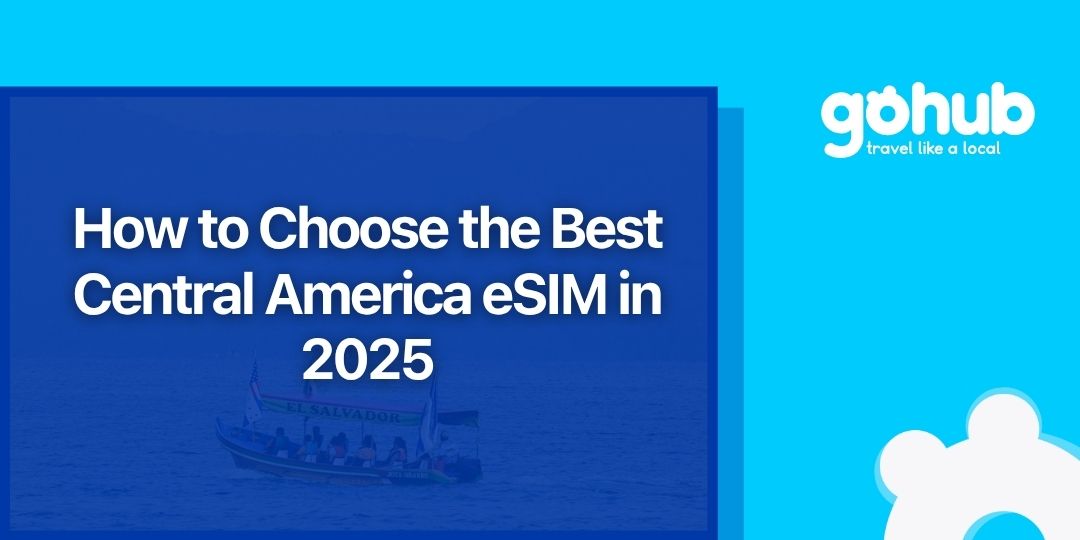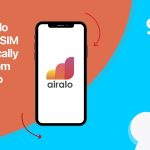Staying connected while traveling through Central America isn’t just about convenience anymore — it’s essential. Whether you’re navigating unfamiliar streets in Guatemala, hopping between beach towns in Nicaragua, or working remotely from a café in Costa Rica, having reliable mobile data can make or break your trip.
In the past, travelers often relied on local SIM cards — which can work, but usually involve finding a store, showing your passport, and figuring out how to top up. Today, travel eSIMs offer a simpler, more flexible solution. With just a quick scan of a QR code, you can connect to a local network before you even leave the airport.
But with so many eSIM options available, it’s not always clear which one gives you the best value — especially if you’re traveling across multiple countries in Central America.
That’s where this guide comes in. We’ll walk you through:
- How eSIMs work in Central America
- The difference between eSIMs and local SIM cards
- A comparison of popular providers (including Gohub, Airalo, and others)
- What to look for in terms of price, coverage, and support
If you’re looking for a Central America eSIM that’s affordable, easy to set up, and works across borders, you’re in the right place.
I. Why Use an eSIM for Central America Travel?
If you’re planning a trip through Central America, chances are you’ll be moving across borders — maybe spending a few weeks in Costa Rica, popping into Nicaragua for the surf, and then heading up to Guatemala for volcano hikes and colorful markets. That’s where a travel eSIM becomes your best friend.
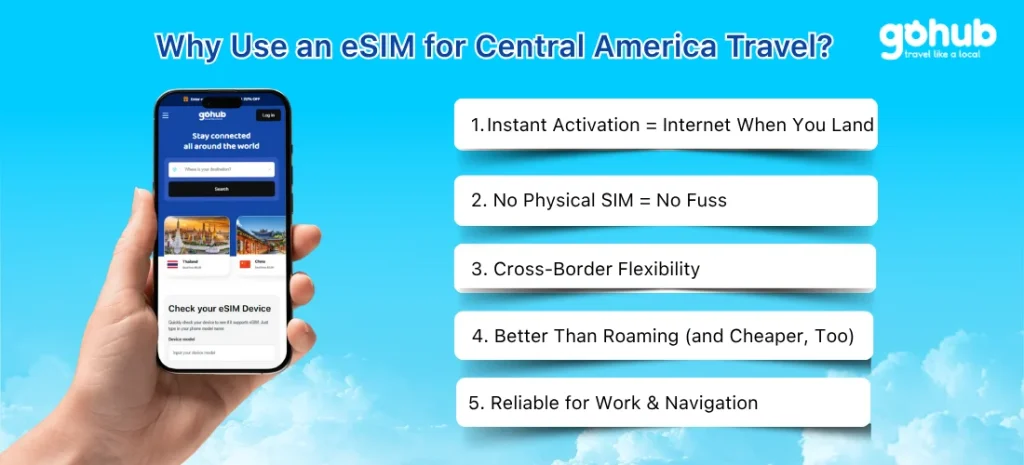
Here’s why it’s a smart move:
1. Instant Activation = Internet When You Land
With a travel eSIM, you can install and activate your data plan before you arrive. That means no hunting for a SIM card kiosk after a red-eye flight or trying to translate “Do you sell prepaid chips?” in Spanish. Just scan a QR code, turn on data, and you’re online.
2. No Physical SIM = No Fuss
No need to remove your home SIM or worry about losing that tiny tray ejector pin. eSIMs work digitally inside your phone, so switching networks is as easy as tapping a few buttons.
3. Cross-Border Flexibility
Most local SIM cards lock you into one country’s network. But with a regional Central America eSIM, you can move between countries without losing signal or buying a new SIM each time. Providers like Gohub offer multi-country coverage, so you stay connected from coast to coast.
4. Better Than Roaming (and Cheaper, Too)
Using your home SIM with international roaming? That’s a quick way to burn through cash. Travel eSIMs let you avoid roaming fees entirely, and plans from providers like Gohub start at just $4.99, making them one of the most cost-effective options available.
5. Reliable for Work & Navigation
Whether you’re checking maps, booking buses, joining a Zoom call, or just updating your travel blog, having consistent, high-speed internet makes your trip easier (and safer). Most eSIMs connect to major networks like Claro, Movistar, or Tigo, depending on location.
Bonus: No Passport Required
Unlike local SIMs (which sometimes need ID verification), eSIMs are all digital. No passport scans, no paperwork, no waiting in line — just download, activate, and go.
In short:
If you want to skip the hassle, stay online across multiple countries, and avoid overpriced roaming charges, a Central America eSIM is your best bet.
👉 Up next, we’ll compare the most popular providers — and show you why Gohub stands out for price, coverage, and customer support.
II. Gohub vs. Airalo vs. eSIM4Travel: Which eSIM Works Best in Central America?
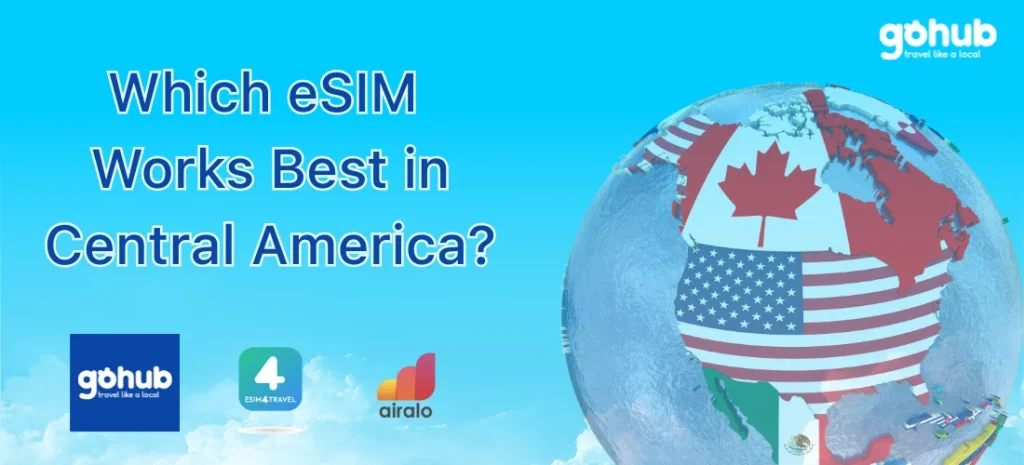
There’s no shortage of travel eSIM providers out there, but not all of them are created equal — especially when it comes to traveling through Central America. We’ve compared the three most talked-about options among digital nomads and frequent travelers:
1. Gohub – Best Value for Multi-Country Trips
Gohub is quickly becoming a favorite among budget-savvy travelers looking for reliable eSIM coverage across multiple countries, especially in Latin America and Southeast Asia.
What makes Gohub different?
- Affordable plans starting at just $4.99 — up to 50% cheaper than Airalo
- Multi-country coverage across Costa Rica, Nicaragua, Guatemala, Panama & more
- Instant activation via QR code – ready before you land
- 24/7 live chat support in English, Vietnamese, Korean, and Chinese
- Flexible data packages by day or GB – no waste, no guesswork
- Full refund if the eSIM doesn’t activate
Perfect for: Digital nomads, regional travelers, and anyone hopping across borders with one device
2. Airalo – Most Popular, But Not Always the Cheapest
Airalo is the most well-known travel eSIM brand globally, with wide coverage and a user-friendly app.
Pros:
- Coverage in 200+ countries
- Easy setup via app
- Offers regional “LatamLink” plans (17 countries in Latin America)
Cons:
- Prices start at $15 for 1GB/7 days – more expensive than Gohub
- Not all plans allow hotspot/tethering
- No live human chat support – mostly self-service
Best for: Travelers who value convenience and don’t mind paying extra
3. eSIM4Travel – Reliable Support, Moderate Pricing
eSIM4Travel offers decent pricing with a strong emphasis on customer service.
Pros:
- Live chat support with real humans
- Reasonable prices and multiple plan durations
- Clear setup instructions
Cons:
- Limited regional options — plans are often single-country
- Speeds can vary depending on the region
Best for: First-time eSIM users who may need assistance with setup
Quick Comparison Table:
| Feature | Gohub | Airalo | eSIM4Travel |
|---|---|---|---|
| Starting Price | $4.99 | $15 | ~$8 |
| Coverage Type | Multi-country | Regional | Mostly single |
| Hotspot Support | ✅ Yes | ❌ Limited | ✅ Usually |
| Customer Support | ✅ 24/7 Live Chat | ❌ Ticket-based | ✅ Live Chat |
| Refund Guarantee | ✅ Yes | ❌ No | ❌ No |
| User Language Support | EN, VI, KR, CN | EN Only | EN Only |
| App Available | Coming Soon | ✅ Yes | ❌ No App |
In short:
If you’re looking for the best value eSIM for Central America, with real support, flexible data, and no roaming surprises, Gohub is hard to beat.
III. Local SIM Cards in Central America – Are They Still Worth It?
While travel eSIMs are super convenient, there are still situations where buying a local physical SIM card might make sense — especially if you’re staying in one country for an extended period or want to squeeze every last dollar from your data spend.
Here’s a breakdown of what to expect if you go the traditional route:
Where to Buy Local SIMs
In most Central American countries, buying a local SIM card is relatively easy — especially in big cities or airports. Here are some quick examples:
- Costa Rica: Major providers include Kolbi, Claro, and Movistar. You can buy SIMs at official retail stores or convenience shops like Mas x Menos.
- Guatemala: Tigo and Claro dominate the market. SIMs are available at street vendors, malls, or kiosks.
- Nicaragua: Look for Claro or Movistar – available at authorized stores or even gas stations.
🪪 You’ll usually need to show your passport to register the SIM. Some shops might activate it for you, others may require you to figure it out with local instructions or an app in Spanish.
Cost of Local SIMs
Local SIMs can be cheaper per GB than many eSIM options — but not always by much. For example:
- Guatemala: You might pay ~$2 for the SIM and ~$6 for 2GB valid 7 days
- Costa Rica: 5GB can cost around $8–10, valid for 15–30 days
- Mexico (if continuing north): SIM cards are available at OXXO for ~$1.50 USD
However, costs vary, and recharging or managing your balance often requires using a local app or walking to a store.
Coverage & Network Lock-in
One downside: local SIMs are locked to a single provider, which might have patchy coverage depending on where you are.
For example:
- Movistar may be great in urban Nicaragua, but weak on rural coasts.
- If you’re crossing borders, you’ll need a new SIM for each country.
Flexibility & Hotspot Use
Some local SIMs support hotspot/tethering, but it’s not always guaranteed. You’ll also need to swap SIMs physically, which can be annoying if you use two-factor authentication (2FA) or need to keep your home SIM active.
When a Local SIM Makes Sense
Use a local SIM if:
- You’re staying in one country for more than a month
- You don’t plan to cross borders
- You’re on a tight budget and okay with a bit of hassle
- You’re fluent enough (or patient enough) to deal with setup in Spanish
When an eSIM Like Gohub Is Better
Stick with an eSIM if:
- You’re traveling across multiple countries
- You value instant setup and customer support
- You prefer to avoid SIM registration & passport checks
- You want one solution for your whole trip — no swap needed
Bottom line:
Local SIMs can work — but eSIMs offer more flexibility, faster setup, and better support, especially for regional travel.
IV. eSIM vs. Local SIM Card in Central America: Which One’s Right for You?
When it comes to staying connected while traveling through Central America, you’ve got two main options: a travel eSIM or a local physical SIM card. Both can get you online—but which one fits your travel style, tech comfort, and budget?
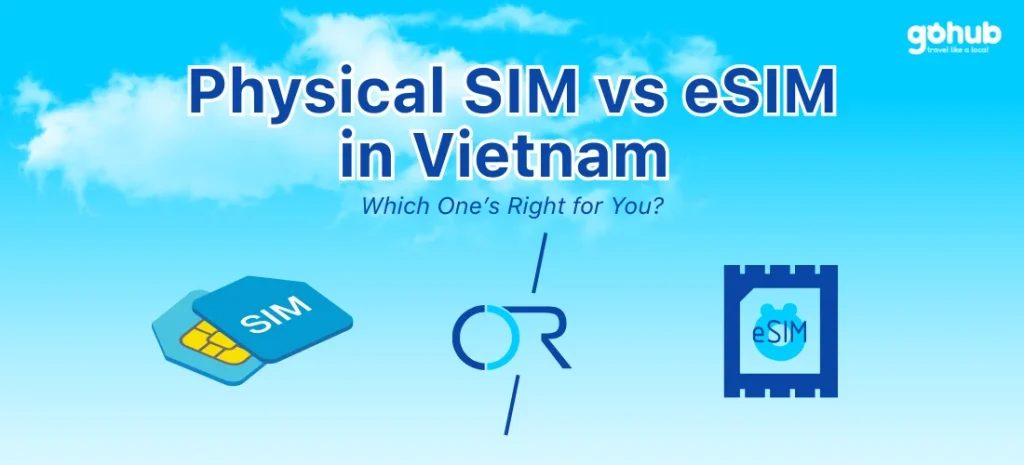
Let’s break it down clearly:
eSIM: Digital Convenience Across Borders
Why travelers love eSIMs:
- ✅ Activate before you land — just scan a QR code
- ✅ No need to swap SIM cards or remove your home line
- ✅ Works across multiple countries (perfect for cross-border trips)
- ✅ Can auto-switch between networks for stronger signal
- ✅ No store visits, no passport required
- ✅ Support in multiple languages (e.g., Gohub offers live chat in EN, VI, KR, CN)
Downsides? Slightly higher cost per GB compared to local SIMs, though services like Gohub now start at just $4.99.
Local SIM Cards: Budget-Friendly (If You Stay Put)
Why some travelers still use them:
- ✅ Often cheaper per GB, especially for long stays
- ✅ Widely available in-country (airports, kiosks, convenience stores)
- ✅ Easy to top up with small data amounts
But you’ll deal with:
- Time spent buying and activating in-store
- Passport registration in most countries
- Limited to one network (coverage may vary by area)
- Needing to swap SIMs at every border
- Potential loss of access to apps tied to your home number
Side-by-Side Comparison
| Feature | eSIM (e.g., Gohub) | Local SIM Card |
|---|---|---|
| Setup | Online, instant with QR code | In-store, manual setup |
| Passport Required | ❌ No | ✅ Usually |
| Country Coverage | 🌎 Multi-country (1 plan for region) | 🚫 One country only |
| Network Flexibility | ✅ Multi-network fallback | ❌ Locked to one provider |
| SIM Swapping | ❌ None – all digital | ✅ Physical swap required |
| Tethering/Hotspot | ✅ Usually supported | ✅ Often supported |
| Customer Support | ✅ Live chat (Gohub, eSIM4Travel) | ❌ Varies, often none |
| Language | 🌐 Multilingual (e.g., English, Vietnamese) | 🇪🇸 Mostly Spanish only |
| Refund Guarantee | ✅ Available (with Gohub) | ❌ Rare or non-existent |
💡 So, Which Should You Choose?
- Choose an eSIM if you’re visiting 2+ countries, prefer instant setup, or want to avoid language barriers and local logistics.
- Choose a local SIM if you’re staying in one place long-term, speak the language, and want the absolute lowest price.
✨ Tip: Gohub’s Central America eSIM gives you regional coverage, flexible plans, and 24/7 support — all starting from $4.99.
👉 Check available plans here
V. How to Set Up Your eSIM for Central America (Step-by-Step)
One of the best things about using an eSIM for travel? It’s ridiculously easy to set up — no tech wizardry required. Whether you’re heading to Costa Rica, Guatemala, Nicaragua, or all three, you can activate your Central America eSIM in just a few minutes.
Here’s exactly how to do it:
Step 1: Check if Your Device Supports eSIM
Most modern phones support eSIM, but it’s smart to double-check.
How to check:
- Go to Settings → Cellular (or Mobile Network)
- Look for “Add eSIM” or “Add Cellular Plan”
- You can also check Gohub’s Device Compatibility List
📱 Popular supported models include iPhone XR and up, Google Pixel 4+, Samsung Galaxy S20+, and many more.
Step 2: Choose a Plan That Matches Your Trip
Before buying, consider:
- How many countries will you visit?
- How many days will you stay?
- Will you use hotspot/tethering?
- Light or heavy data usage?
🔍 Gohub makes it easy with regional plans by GB or by day — so you’re not stuck overpaying or running out.
Step 3: Purchase and Receive Your QR Code
Once you select your eSIM plan:
- Complete the purchase on Gohub
- You’ll receive an activation QR code via email
- You can also access it directly from your Gohub dashboard
Step 4: Install the eSIM Profile
Scan the QR code using your phone’s camera via:
- Settings → Mobile Network → Add eSIM / Add Cellular Plan
- Select “Use QR code”
- Follow the prompts to finish installation
It usually takes under 2 minutes.
✨ Pro Tip: You can install the eSIM before your flight — just wait to activate mobile data when you arrive.
Step 5: Turn On Data & Roaming
Once you’re in Central America:
- Open Settings
- Turn Roaming ON for the eSIM
- Set the eSIM as your default data line (keep your physical SIM off if not needed)
Step 6: Do a Quick Connection Test
Open your browser or maps app to check if data is working. If it doesn’t connect:
- Toggle Airplane Mode off and on
- Make sure mobile data is turned on
- Contact Gohub’s 24/7 live chat for support
And that’s it!
No waiting in lines. No fumbling with tiny SIM trays. You’re now online and ready to explore Central America — one volcano, beach, and border crossing at a time.
🌐 Ready to try it? Browse Gohub’s Central America eSIM Plans
VI. FAQs About eSIMs in Central America
💡 Got questions? You’re not alone.
Here are the most common things travelers ask before choosing an eSIM for Costa Rica, Guatemala, Nicaragua, and beyond:
❓ Can I use one eSIM across multiple Central American countries?
Yes. If you choose a regional eSIM plan (like those from Gohub), you’ll get coverage across multiple countries — no need to switch SIMs or buy new ones when you cross borders.
❓ Is an eSIM more expensive than a local SIM?
Sometimes. Local SIMs can be cheaper per GB, but they come with hassle: passport registration, finding a store, and being locked into one country.
Gohub offers budget-friendly regional plans starting at $4.99, often cheaper than roaming or buying multiple local SIMs.
❓ Will I get good coverage with an eSIM?
Yes. Most travel eSIMs, including Gohub, connect to major local networks like Claro, Movistar, or Tigo — and some plans auto-switch to the strongest signal in your area.
❓ Can I use hotspot/tethering?
In most cases, yes. But it depends on the provider and plan. Gohub clearly indicates which plans support hotspot use, so you’re not left guessing.
❓ How do I know if my phone supports eSIM?
- Check in Settings → Mobile Networks or Cellular Settings
- Look for options like “Add eSIM” or “Add Cellular Plan”
- Or visit Gohub’s compatibility guide
❓ Can I keep my physical SIM active while using an eSIM?
Yes! Most dual SIM phones let you use eSIM for data while keeping your physical SIM for calls/texts or 2FA. Just make sure your phone’s data line is set to eSIM.
❓ What happens if my eSIM doesn’t work?
If you’re using Gohub:
- Contact 24/7 live chat support
- If there’s a technical failure, Gohub offers a 100% refund policy
- You can also switch to another eSIM plan directly from your dashboard
❓ Can I use an eSIM for calls and texts?
Most travel eSIMs are data-only. You can use apps like WhatsApp, Telegram, Signal, FaceTime Audio, etc., for calls and messages.
Gohub is working on adding voice-enabled plans in the near future.


